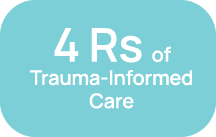ACEs In Healthcare
Experts and healthcare professionals are increasingly advocating for the integration of trauma-informed care within health service delivery frameworks.
This means not just treating physical ailments, but also recognizing and addressing the emotional scars that ACEs leave behind.
Integrating Trauma-Informed Care
To do this effectively, it is essential to have a comprehensive approach that includes education, prevention, and specific strategies for assessing and treating trauma.
This often means overhauling entire systems so that everyone understands how trauma affects people, families, and communities.

A UNIVERSAL
Precaution
Just as handwashing serves as the universal precaution to prevent the spread of infection, trauma-informed care should similarly be regarded as the universal precaution in interactions with patients.

Researchers are working hard to ensure that the insights from ACEs studies can be applied to practice initiatives.
For practitioners, this means having solid evidence to guide their clinical decisions, like knowing the best ways to assess and treat ACEs. For policymakers, it means having reliable information to plan programs and allocate resources to help those most at risk.
And for the public, it’s about increasing awareness and understanding of ACEs, their toxic effects, and links with health outcomes. Ultimately, we want to educate people about the serious impacts of ACEs, reduce the stigma around mental health issues related to ACEs, and advocate for fair treatment for everyone by taking a trauma-informed approach.

More and more organizations are adopting this trauma-informed approach. This is encouraging because it shows a greater understanding of how widespread trauma is and how it impacts health.
Six key principles of a trauma-informed approach
Outlined by The Substance Abuse and Mental Health Services Administration (SAMHSA)
ACEs IN HEALTHCARE
ACEs Screening
When an organization or agency adopts trauma-informed care, they may choose to assess for ACEs using a patient questionnaire. Some healthcare providers believe that understanding a patient’s ACEs can offer insights into their history and potential health risks.
This knowledge allows them to tailor interventions to the individual’s needs, ultimately promoting better health outcomes.

In line with trauma-informed care principles, it is recommended that patients be given the option to complete the ACE Questionnaire. For example, a practitioner might say, "We ask all our patients these ACEs questions to better understand your health and well-being. Would you be comfortable answering them?"
Many healthcare settings, like primary care, family doctors’ offices, and women’s health centers, now incorporate ACEs screening as part of their routine care.

POST-ASSESSMENT
After assessing ACEs, healthcare providers should engage patients in discussions about how past and present stressors may impact their health.
POSSIBLE QUESTIONS
"I see that you have had some challenging experiences growing up. How has that impacted you?"
"How many of these experiences continue to negatively impact you now?"

SUPPORTIVE RESOURCES
Additionally, practitioners should help patients identify supportive resources to cope with stress and help promote resilience.
POSSIBLE QUESTIONS
"What supports did you have growing up?"
"What supports or resources would you like now?"
By understanding how past experiences influence current functioning and well-being, patients can feel empowered to address chronic conditions head-on. Together with their healthcare provider, they can develop strategies to enhance resilience and minimize the impact of ACEs on their health.


The ACEs Aware website provides valuable resources for clinicians interested in implementing ACEs screening. It outlines the components of a comprehensive ACEs screening, including the ACE Score, associated health conditions, and protective factors. It also provides a link to the ACEs and Toxic Stress Risk Assessment Algorithm..
- The ACE score
- Associated health conditions
- Protective factors
- ACEs and toxic stress risk assessment algorithm
ACEs IN HEALTHCARE
Clinical Assessment and Treatment
After screening for ACEs, healthcare providers can turn to proven interventions and trauma-informed care methods to help patients prevent and manage the effects of toxic stress.
The main aim of assessing ACEs clinically is to understand a patient’s childhood exposure to ACEs and toxic stress and to use this insight to create a personalized treatment plan that enhances their physical health and mental well-being.




The ACEs Aware website offers practical guidance on conducting a clinical assessment and devising a treatment plan. This includes gathering patient information, using the ACEs and Toxic Stress Risk Assessment Algorithm for assessment, and crafting a response that involves patient education, support services, stress reduction strategies, referrals to additional resources, and ongoing care.




